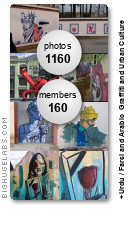Wednesday, January 10, 2007
Graffiti for God!!!
========================
Artist Mohammed Ali has a very unique Stencil on canvas style - his inspiration is the Arabic script in the Holy Qur'an. He fuses the art forms, reflecting the energy of the urban Muslim living in the West

Stenciling often conjures up images of vandalism and urban decay. Mohammad Ali's art challenges these assumptions by taking graffiti from the walls to canvas. He fuses two very different artistic forms by drawing on his faith and the energy of the street to create a style that is uniquely western and Islamic.
"My fascination with graffiti goes back to the early days. I remember always doodling and sketching outlines. I couldn't connect with the depressing lives that 'great' artists lived. Studying Van Gogh's life wasn’t for me. I didn't want my art to drive me to that.
"I needed something real, real to me, something that was within reach. Aerosol paint was just what I needed. I could finally be the artist. It didn’t matter to me if the art teacher approved or not. I was doing my own thing. I would choose the colours and I drew what I felt."
Mohammed is from Kings Heath in Birmingham and at just 25 years of age he is keen to inspire kids in Birmingham. He found his religion while at university, and believes that mixing the street art of graffiti with religion is a more succesful way for young people to connect with their faith;

"Every youth has admiration for graffiti and can connect with it. It's a much more approachable artform - mix it with religion and you're giving people back their faith too.
Far from vandalising public property, Mohammed's graffiti-style art is done as individual pieces using spray paint on canvas.
"Back in the day if I'd have seen graffiti in Arabic I would have followed my faith more - it would have inspired me. It seemed like religion was for old folks, and I want to give it back to the kids."
"Going back to the Qur'an I was struck by the sublime beauty of the Arabic script. The very way the words were written was powerful and fluid mirroring the strength of the message and its transcendent significance. I wanted to paint again, but now my inspiration was the Arabic language." 
"Like many young Muslims around me, I became drawn to Islam at University. Feeling that I had neglected something very beautiful for far too long. I considered using my art to reflect my faith. Islam too could be slick, stylish and charismatic. The colours and shapes could reflect the energy of the urban Muslim, living in the west."
Mohammed wants to expand his artwork to clothing, and feels the universal messages in his work such as 'peace' 'knowledge' and 'patience' will be a succesful crossover into youth culture.
He hopes his graffiti art work will serve as a bridge between Islam and the West and to encourage more young people to accept their faith through this new kind of Islamic art.
"I wanted to take an art form that belonged on the street and connect with ordinary people through the divine meaning contained in the book of Allah. be proud of your identity as a Muslim. Do it with confidence."

Article: http://www.bbc.co.uk/
Labels: Article, artist, stencil





